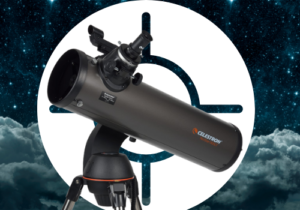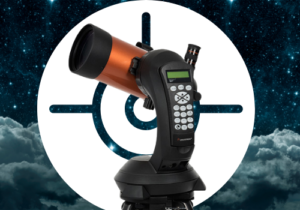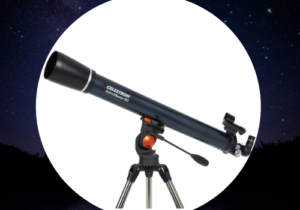Celestron NexStar 90SLT Review: Should You Buy It?
Disclosure: This post contains affiliate links and I may earn a small commission (at no extra cost to you) if you click through and make a purchase. Thanks in advance – I really appreciate it!
Welcome to my Celestron Nexstar 90SLT Review!
The Celestron NexStar 90SLT is designed to offer consumers an overall package of excellent basic features that make its operation and use easy and rewarding.
In this review, I will cover everything that you need to know about NexStar 90SLT in order to decide whether you should buy this telescope or not.
My Verdict
Designed as a highly portable and user-friendly telescope for beginners and intermediates, the NexStar 90SLT 90mm f/14 Maksutov-Cassegrain GoTo Telescope gives you the ability to make detailed observations of the Moon, with the ability to easily see planets. You can get great views of the moon, Jupiter, Saturn, Mars, and Venus with the NexStar 90SLT, but it’s not big enough to show you most of the DSOs. This means that you’ll not be able to see most of the 40,000 objects in its database because of its small aperture. Also, the mount drains the batteries rather quickly. The NexStar 90SLT has great, high-quality optics and it is a planetary performer. If you are looking for a GoTo telescope with Auto-Tracking features which excels at planetary and lunar performance then Celestron NexStar 90 SLT is a very good choice.
Pros
- Great optics.
- Maksutov Cassegrain design.
- Excellent views of the moon and the planets.
- Compact & highly portable.
- Limited astrophotography.
- 2-Year warranty.
Cons
- Disappointing DSO performance.
- Cheap eyepieces.
- Drains batteries quickly.
- Not for serious astrophotography.
- Computerized Star Locating Telescope: The Celestron NexStar 90SLT is a computerized telescope that offers a database of more than 40,000 stars, galaxies, nebulae, and more. The telescope locates your object with pinpoint accuracy and tracks it
- Compact and Portable: This telescope for adults and kids is ideal for weekend camping trips or excursions to dark sky sites. Its compact form factor makes it easy to transport and assemble just about anywhere
- Maksutov-Cassegrain Optical Design: The NexStar 90SLT is the smallest in the SLT family. The 90mm aperture gathers enough light to see our Solar System and beyond. View Saturn's rings, Jupiter's cloud bands, and the Moon in brilliant detail
- Fast Setup with SkyAlign: Celestron's proprietary SkyAlign procedure has you ready to observe in minutes. Simply center any three bright objects in the eyepiece and the NexStar SLT aligns to the night sky, ready to locate thousands of objects
- The NexStar 90SLT Computerized Telescope includes a free download of one of the top consumer-rated astronomy software programs for an interactive sky simulation
Celestron NexStar 90SLT Review
The NexStar 90SLT is a small Maksutov-Cassegrain telescope that comes equipped with Celestron’s technological offerings.
The telescope is engineered with, preassembled, adjustable stainless steel tripods, and quick-release fork arms and tubes. The NexStar 90SLT can be set up in a matter of minutes without the use of any tools.
It is a planetary performer, so Auto-Tracking and GoTo abilities feel more useful.
Optical Performance
1. Maksutov-Cassegrain Design
The NexStar 90SLT has a 90mm aperture with a Maksutov-Cassegrain design.
The Maksutov-Cassegrain optics use a combination of lenses and mirrors so they typically have all the best qualities of reflector and refractor telescopes.
Mak-Cass telescopes such as NexStar 90SLT do not suffer from chromatic aberrations and are best for viewing planets.
Since Mak-Cass is a closed tube design which means the optics aren’t exposed. As a result – maintenance is not required all too often.
Moreover, the optics remain free of dust and bugs and unaffected by environmental factors such as humidity, cold, and heat so Mak-Cass telescopes in general last a very long time.
Also, NexStar 90SLT is quite compact and portable for its size.
2. Optics
As a small Maksutov-Cassegrain telescope, the NexStar 90SLT delivers what you expect it to. That is highly focused views of nearby space that produce high-quality images of the well-known sky objects.
The 90SLT has an aperture of 90mm, a focal length of 1250mm which results in a focal ratio of f/14.
The 90SLT is a small telescope with an extremely high focal ratio of f/14. This means it is going to only truly be good at looking at single bright objects. It is not going to be able to scan the sky for deep space objects.
The Celestron NexStar 127SLT has been featured in the following articles:
3. What Can You See With NexStar 90SLT?
The NexStar 90SLT is great for viewing the moon and most of the planets, but with its small aperture, it is not capable of showing you that many deep-space objects.
The NexStar 90SLT really shines when it comes to viewing the moon. You can see the moon’s surface in great detail along with many craters and mountain ranges.
If you are going for Lunar observations specifically, NexStar 90 SLT is an excellent choice. NexStar 90SLT is also great at taking amazing pictures of the moon.
You can easily view Jupiter, its stripes, Galilean Moon’s, and The Great Red Spot.
It will also show you great views of Saturn, its ring, the Cassini Division, and a couple of its moons.
Mars and Venus can be seen as colorful disks through NexStar 90SLT.
You can observe some detail on the surface of Mars, and the phases of Venus are relatively clear.
When it comes to DSOs, don’t expect much with NexStar 90SLT.
You may be able to see a few bright nearby star clusters and galaxies but that’s it.
With a 90mm aperture and a focal ratio of f/14, the images are narrow it is hard to fit in the field of view.
Computerized Mount
The computerized mount used is a GoTo Altitude-Azimuth Single Fork Arm one with SkyAlign technology and a hand controller with a database of 40,000 celestial objects.
The mount can be powered using 8 AA batteries (not included) or through the use of a 12V AC adapter.
The batteries run out pretty quickly, they may last only 4-5 hours. Then eventually you will have to use another power source.
I highly recommend buying a 12V AC adapter or Celestron’s PowerTank (Amazon links open in new tabs).
The tripod is a thinned-out steel model. It is not the usual rock-solid steel tripod that comes with expensive telescope models.
But, it is vastly better than aluminum versions that are common among budget telescopes.
SkyAlign Technology
To use its SkyAlign technology, simply input the date, time, your location (the CPC models have built-in GPS that does this for you), and then align the telescope to three bright stars of your choosing.
You do not need to know the names of the stars, you could even pick the Moon or bright planets.
The NexStar Computer system will automatically figure out which stars were chosen and then align the telescope.
There is no need to point the telescope North or to level the optical tube; the initial position of the telescope is irrelevant. This makes for a fast and very easy method for aligning the telescope.
Once the telescope is aligned, you can choose the sky object of your choice from the menu in the hand controller and the NexStar 90SLT will automatically slew itself towards that sky object, which you will be able to see through the eyepiece.
Here’s the Problem!
Although the SkyAlign technology boasts of a 40,000 object database, with the telescope’s small aperture and a focal ratio of f/14, the NexStar 90SLT simply cannot see most of the objects included in the database.
Quite frankly the Celestron NexStar 8SE (review page opens in new tab) is the only telescope that can see all of the 40,000 sky objects in Celestron’s database.
But in the case of NexStar 90SLT, the combination of low light gathering capability and a high focal ratio means that the SkyAlign technology, the database, and the goto mount are going to be extremely undervalued here.
Astrophotography
The NexStar 90SLT is only good for short exposure astrophotography. This limits you to relatively sharper planetary and Lunar imaging.
As I have mentioned before, with NexStar 90SLT you can take decent pictures of the moon and larger planets.
However, if you are looking to get into serious astrophotography, then look elsewhere. The NexStar 90SLT is not meant for serious astrophotography due to the nature of its alt-azimuth mount.
Make sure that you use a smartphone camera or a lightweight CCD camera to take pictures as the mount is not strong enough to bear the weight of a DSLR.
Included Accessories
In the box you’ll be provided with the following:
- NexStar 90 mm Maksutov-Cassegrain SLT OTA.
- NexStar computerized altazimuth mount.
- NexStar tripod, with adjustable stainless steel legs and bubble level.
- Accessory tray.
- NexStar+ hand control.
- StarPointer finderscope/ red dot.
- 1.25-inch Star Diagonal/ Erect Image.
- 1.25-inch 25mm eyepiece (13x magnification).
- 1.25-inch 9mm eyepiece (50x magnification)
- TheSky and First Light/ planetarium software on CD ROM.
- 2 Year Warranty.
The eyepieces are Kellner models. They are budget eyepieces and are enough to get you started, but I highly recommend buying new better-quality eyepieces as soon as you get the hang of the telescope.
Celestron NexStar 90SLT: Limitations
The Celestron NexStar 90SLT boasts of a large database and amazing technology but leaves the user unsatisfied. This telescope is simply far too small to make use of all of the technology and the large database that it advertises.
This is a very good computerized telescope for viewing the moon and planets but not much beyond that.
NexStar 90SLT is quite disappointing when it’s used to view the fainter DSOs.
I also don’t like that Celestron doesn’t provide a built-in battery along with the mount. The mount eats away 8AA batteries pretty rapidly and buying more batteries, even the rechargeable ones just adds to the cost.
Conclusion
The NexStar 90SLT is an excellent computerized telescope that is also affordable, easy to set up, easy to use, and comes with educational information. This telescope allows the beginner to afford to learn more about the nighttime sky, learn the basics of stargazing, and enjoy breathtaking views, all with a minimum of effort.
Written by:

Jason Parnell
At 15, I sold my bike to buy my first telescope. I spent the next 3 years sketching as many Messier objects as I could find from my garden, then at the age of 18, I discovered beer. I have wandered through California's Mojave Desert with other amateur astronomers in search of the best stargazing experience.
ABOUT US
We are a team of active amateur astronomers, here to help you with all your astronomy and science related needs – this is anything, from reviewing the latest telescopes to be released to talking about gravity and neurons. The Big Bang Optics was started because of our love for astronomy and to help others like us find the best telescope and accessories.
LEGAL DISCLAIMER
The Big Bang Optics is a participant in the Amazon Services LLC Associates Program, an affiliate advertising program designed to provide a means for sites to earn advertising fees by advertising and linking to Amazon.com. The Big Bang Optics also participates in affiliate programs with Clickbank and other sites. The Big Bang Optics is compensated for referring traffic and business to these companies.





